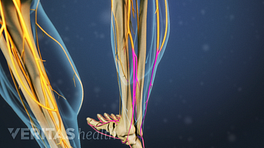There is currently insufficient evidence to definitively recommend shoe insoles for specific types of lower back pain, such as a herniated disc or degenerative disc disease. However, there is emerging clinical evidence supporting the use of foot orthotics as a potential treatment option for lower back pain in general.
Some of the research and conclusions supporting the use of foot orthotics are controversial. For example, a 2013 systemic review of relevant studies concluded that there is insufficient evidence to support the use of shoe insoles or foot orthoses for treatment of lower back pain, citing problems with the studies reviewed—such as a small number of trial participants, which may have weakened the studies’ conclusions.1
See Non-Surgical Treatments for Lower Back Pain
Foot Problems and Lower Back Pain
Many studies have found evidence of foot problems associated with lower back pain. For example, a December 2013 study examined foot posture and function and its possible relationship with low back pain.2 The study included a large patient population of 1,930 subjects, and concluded that foot orthoses may have a role in the prevention and treatment of lower back pain, as the incidence of pronated foot function (rolling in of the ankle and flattening of the medial arch) was found to be associated with low back pain—with a higher incidence in women.
A 2011 study published in the Journal of Manipulative and Physiological Therapeutics recruited 50 patients with a medical history of chronic low back pain. The patients were fit with custom foot orthotics and then compared to a control group that did not receive them.3
At the end of 6 weeks, a comparison of the two groups showed the foot orthotic group had improved scores for both pain and function. Participants in the control group were then fitted with prescription foot orthotics, and they subsequently reported improvements similar to the initial treatment group.
However, there was no further improvement at the end of 12 weeks in the initial treatment group when compared to their six-week scores for pain and disability levels. Patients with chronic low back pain (“chronic” meaning pain lasting longer than 3 months) improved with the use of foot orthotics after six weeks, at a point that remained constant after 12 weeks (they did not experience further improvement beyond the 6-week mark). This study therefore supports a rather immediate benefit from the use of foot orthotics, much like the previously described 2013 study that addressed patients with lower-limb biomechanics issues.
More recently, a 2013 double-blind, randomized, controlled study of 51 participants with excessive ankle pronation and chronic low back pain (43 women and 8 men) studied pain and disability outcomes for one group receiving custom-made foot orthoses and a control group treated with placebo.4 After four weeks, the treatment group showed significant improvement in both pain and disability versus the control group.
One question that remains unanswered is whether patients suffering from specific a low back conditions, such as a herniated disc, spinal stenosis, or compression fracture, are more likely to benefit from the use of foot orthotics.
References
- 1.Chuter V, Spink M, Searle A, Ho A. The effectiveness of shoe insoles for the prevention and treatment of low back pain: a systematic review and meta-analysis of randomised controlled trials. BMC Musculoskelet Disord. 2014 Apr 29;15:140. doi: 10.1186/1471-2474-15-140.
- 2.Menz HB, Dufour AB, Riskowski JL, Hillstrom HJ, Hannan MT. Foot posture, foot function and low back pain: the Framingham Foot Study. Rheumatology (Oxford).2013 Dec; 52(12):2275-82. doi: 10.1093/rheumatology/ket298.
- 3.Cambron JA, Duarte M, Dexheimer J, Solecki T. Shoe orthotics for the treatment of chronic low back pain: a randomized controlled pilot study. J Manipulative Phys Ther 2011; 34 (4):254-260.
- 4.Castro-Mendez A, Munuera PV, Albomoz-Cabello M. The short-term effect of custom-made foot orthoses in subjects with excessive foot pronation and lower back pain: a randomized, double-blinded, clinical trial. Prothet Orthot Int 2013; 37 (5):384-90.







